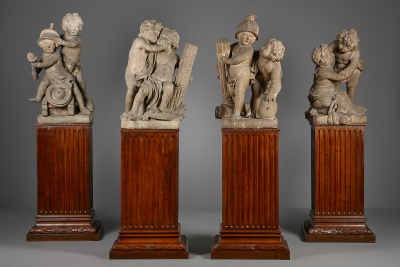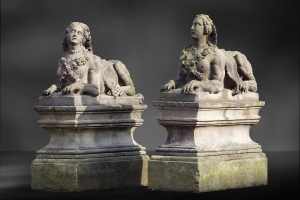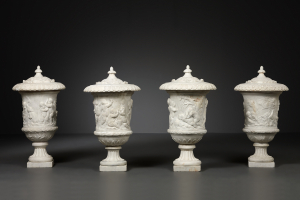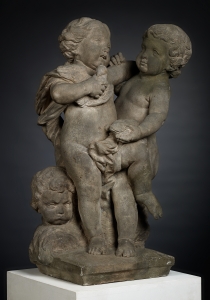Jan Claudius de Cock, Four sandstone statues, an Allegory of the Peace of Utrecht
Jan Claudius de Cock, Four sandstone statues, an Allegory of the Peace of Utrecht
The recent rediscovery of this group of statues meant an important addition to the known oeuvre of the Flemish sculptor Jan Claudius de Cock. The four statues represent the various stages of war, surrender, victory, peace and reconciliation involved in the Peace of Utrecht of 1713, and taken together they perfectly embody the powerful visual idiom, knowledge and exceptional skill of Jan Claudius de Cock.
The peace talks held in Utrecht in 1713 and in Baden-Baden in 1714 were a landmark event in European political history and laid the foundations for the state system as it exists today. They brought an end to the War of the Spanish Succession, closing the book on a global-scale conflict and restoring the balance of power in Europe. The lengthy sequence of talks resulted in a number of treaties, the first of which was concluded in Utrecht on 11 April 1713, hence the name by which the series of diplomatic conventions is known.
The success of the peace talks was due to the diplomatic and legal principle that the victors and the vanquished would be treated equally in the negotiations and the outcomes, and that the parties would jointly strive to establish a balance of power and, as a result, peace and tranquillity in Europe – a milestone in the history of international relations. These relations are also reflected in the iconography of this statue group.
Iconography and contextual analysis
The new balance of power and the manner in which it came about are reflected in the present statue group. The two putti around the mortar represent Militancy. The cannon and helm represent conflict or war; the fasces, power and justice.
The statue of the reconciling putti partially includes the same attributes, but in a completely different setting. The shield of Pallas Athena and the sword represent conflict, but they are being trod underfoot, because the war is over. The visual idiom employed suggests a peace obtained through conflict. The holder of the fasces is coming to terms with a new balance,
while the striding putti with the fasces and the upright shield represent the new order, in which the two formerly separate parties are united.
The acceptance of the new balance of power by the old order is represented in the group consisting of a kneeling putto being helped up by another youngling.
More specifically, the sculptures can be explained in relation to their context as follows:
- The first group, which shows a putto sitting upon a mortar with a burning torch in hand while a helmet is placed upon his head by a second putto, depicts the willingness to engage in conflict. This relates to the period of the War of the Spanish Succession, which pitted France and Spain against Great Britain, Portugal, the Dutch Republic and the Duchy of Savoy. The younglings around the mortar represent the militant sentiment that prevailed among all the parties involved, not just in the conflict itself, but also in the initial negotiations, as each party sought to prioritise its own interests.
- The second group represents a later phase in the peace talks, in which the parties began to reconcile with the consequences of the long years of war and the changes in their positions, both in Europe and in relation to each other. More specifically, the Medusa shield can be interpreted as a direct reference to the Spanish sovereign. Around 1541, Filippo Negroli crafted a metal shield for Charles V of Spain, as the ultimate symbol of Spain’s power. This shield can still be found in Vienna’s Kunsthistorisches Museum. The fact that the shield is being trod into the dust here may be taken as a mocking reference to the loss of Spain’s dominance over the Low Countries.
- The third group shows the changed national relations in Europe and the shift in the balance of power. More specifically, the youngling with the helmet and fasces – symbolic of his strength – may refer to the Low Countries, who have stood up and freed themselves from Spain’s dominion.
- The group in which one putto helps another to his feet represents the new and old orders jointly searching for harmony and finding a way to cooperate. The kneeling youngling with the crown of laurels and the attributes of power and prosperity beneath him represents Spain, and is being helped up by the other; the group thus represents the old order submitting to the new balance of power, and accepting the hand of the other as an equal. In the new balance of power, people talk things out instead of drawing weapons. This may also be taken as an embodiment of the idea that the victor and the vanquished are leaving conflict behind, and will henceforth treat each other as equals.
There exists a direct connection between these statues and the terracotta statue Bel(lum), i.e. War, which bears Jan Claudius de Cock’s signature and was acquired by Breda’s Museum in 2012. The similarities between this statue and the sandstone group discussed here are unmistakeable. Exactly whom Jan Claudius de Cock created this statue group for remains unknown, though it is clear that it must have been an affluent sympathiser with the Dutch Republic or the Austrian Southern Netherlands, who may have been personally involved in the process that led to the new European balance.
Artistic expressions accompanying peace negotiations were not unusual: a well-known example comes from George Friedrich Händel, who composed the Utrecht Te Deum and Utrecht Jubilate to mark the conclusion of the peace.
Jan Claudius de Cock
The artist Johannes Claudius de Cock (Jan Claudius de Cock) was born in Brussels in 1667. His father was the sculptor Claudius de Cock. Jan Claudius must have learned the basic principles of sculpting from his father before following in his footsteps and apprenticing as a sculptor in the workshop of Peter Verbrugghen the Elder (1615-1686) in Antwerp around the age of fifteen (1682-1683). After the death of Verbrugghen the Elder in 1686, the workshop continued under his sons Peter Verbrugghen the Younger (1648-1691) and Hendrik Frans Verbrugghen (1654-1724). It is generally assumed that the young Jan Claudius de Cock remained with the workshop, and thus learned his craft.
In 1689, De Cock became a master in Antwerp’s guild. He is recorded in this year as “Joannes -Gelouden de Kock beltsnyder” in De Liggeren, the guild’s archive.
The fact that De Cock’s star was already rising at this point is clear from the prestigious commission he received in 1692: to provide the entirety of the statuary for the castle of Breda, the Prinsenhof (Prince’s Court). It was likely during this commission that one of his later apprentices, the painter and artist’s biographer Jacob Campo Weyerman, who grew up in Breda, witnessed the sculptures being created and how De Cock approached his work. In his Levensbeschrijvingen, he notes that De Cock was assisted in Breda by his brother-in-law Melchior Serlippens and seven or eight apprentices. The statues that De Cock produced here were lost during a refurbishment in the nineteenth century. Weyerman spent time in Antwerp in 1719, taking sculpture lessons from De Cock. During this stay, he took advantage of the opportunity to look back on De Cock’s career and to describe his oeuvre:
“Joan Glaudius de Cocq. Is een Antwerps-wicht, een tamelyk goed konstschilder, doch noch beter beeldhouwer, inzonderheit is hy alzo zeer beroemt door zyne bevallige gebytelde kleine naakte kaboutertjes (…) zynde hy zelfs een dwerg van het alderkleinste zoort (…) dat hij een overvlieger is, die veele konstige, zo marmere steene, als houte levens groote beelden, kindertjes en cieraaden heeft uitgehouwen, behalve een oneindig getal uit leem, of potaarde kleine naakte nymphen, boetseryen, vaazen, en andere konstige voorwerpen heeft gebotseert en beworpen. Daarenboven is hy een groot teekenaar en geen minder groot meester in het ordonneeren geweest.”
This description gives us an idea of the broad artistic diversity of De Cock, whose reputation received a tremendous boost after his commission in Breda, drawing attention from future clients in Flanders as well as the Northern Netherlands.
Following his stay in Breda, De Cock is again repeatedly mentioned in Antwerp’s Liggeren archive from 1697 on. These mentions often identify him as a teacher, not only of sculpture but also of drawing.
In addition to sculpture and drawing, De Cock also produced engravings, designed book illustrations, and wrote poetry. The most significant of his poems is Eenighe voornaemste en noodighe regels van de beeldhouwerije om metter tydt een goet meester te worden (Various principal and necessary rules of sculpture to become a skilled master in time), a rhyming didactic treatise. It was only published in 1720, however. In the poem, he criticised the education offered by the academy. The question is: was the academy truly so lacking, or did De Cock see the institute as a competitor? He trained various artists, and was paid for it; furthermore, such students were a source of cheap labour. The fact that De Cock was a poet as well as a sculptor and painter is remarkable, and befitting of his status as a well-spoken artist with the ability to design and produce difficult commissions. Campo Weyerman’s characterisation of De Cock as a Konst-schilder (painter) should be taken with a grain of salt: likely, this was only an excuse to include him in Weyerman’s biographies, which only included painters.
De Cock’s numerous works for churches, cathedrals and monasteries in the Southern Netherlands were interspersed with mythological statues and relief carvings for the gardens and homes of wealthy private clients, many of whom resided in Holland. Towards the end of his career, his network in Holland resulted in a commission for a retable in the Old Catholic Church in Juffrouw Idastraat in The Hague.
Clearly, De Cock was highly appreciated in The Hague: Jacob Campo Weyerman notes that after his death, his daughter travelled to the city with marble statues and models and sold them there. She was aided in this endeavour by the sculptor Jan Baptist Xavery (1695-1742), a native of Antwerp who resided in The Hague.
Jan Claudius de Cock’s oeuvre of drawings largely found its way to Braunschweig and Dresden in the eighteenth century. These 156 sheets, some of which bear drawings on both sides, show that De Cock was a versatile artist; a numbered series of fifteen designs for garden statues from 1699 in particular reveal the artist’s extensive knowledge of mythology and antiquity. With three exceptions, all designs are based on Ovid’s Metamorphoses. Though the series was never executed, several of the sketches were later adapted for other statues. The sketch of the Rape of Proserpina, for example, was redrawn in 1709, and the new drawing was used as the design for a marble statue crafted in 1711, which now stands in the garden of Oostermeer House in Ouderkerk aan de Amstel. Another statue in this series is known only from its clay bozzetto.
Clients
Unfortunately, the clients who commissioned De Cock’s free-standing statues are generally impossible to identify. In churches this often remains clear since the statues have remained fixed in place to this day; but for his other statue groups we can often only guess. For example, we know of two statues depicting groups of children from 1710, representing spring and autumn and executed in white marble, now in the possession of Teylers Museum in Haarlem. Acquired in 1746 by Pieter Teyler at an auction of the inventory of the Keukenhof in Lisse, it may be assumed that they had been previously purchased during a refurbishment of the garden in the 1720s. At that time, the statues were already around fifteen years old and had likely been displayed previously in another garden. Two white marble reliefs from 1707, depicting scenes of Apollo and Daphne and Apheius and Arethusa, were incorporated in the fireplace mantel of the King’s Kabinet at Korte Vijverberg in The Hague around 1725 by Johannes van Schuylenburg, the owner at the time. This example, too, involves pre-existing sculptures.
The client who commissioned the four child groups representing war and peace, an allegory of the Peace of Utrecht, is similarly unknown. With his extensive knowledge of antiquity, mythology and sculpture, and his status as a specialist in the area of child group statues, Jan Claudius de Cock was clearly the man for this job. In the artistic field at that time, De Cock was the only one able to fulfil a commission such as this, given his contacts in both the Northern and the Southern Netherlands, and the high esteem in which he was held in Antwerp and The Hague.
The Peace of Utrecht established a positive trend in Europe, one which saw the different powers cooperate by means of conferences to maintain the balance of power. Inspired by the Peace, the French negotiator Abbé de St. Pierre devised a Plan to bring about an everlasting peace in Utrecht, which he already published in 1713. In this treatise he proposed a new Europe, in which representatives from a large number of states would permanently convene to discuss international problems. In extreme cases, an international armed force could be deployed to enforce peace. It was a visionary suggestion for a united Europe, and shows that the negotiators involved in the talks openly considered a wide range of options to ensure a power equilibrium and peace in Europe. The statues of Jan Claudius de Cock reflect the complexity of the peace negotiations, and may still serve as an example to the world today.
Our thanks to Charles Dumas for granting access to his materials concerning Jan Claudius de Cock. These images will be included in his catalogue raisonné of Jan Claudius de Cock, publication forthcoming.
Literature:
Beeldhouwkunst in de eeuw van Rubens, tent.cat. Brussel, 1977 pp. 37-39
R. de Bruin (red.) In Vredesnaam De Vrede van Utrecht, Rastatt en Baden 1713-1714, tent.cat. Utrecht 2013
C. Dumas, Getekende ontwerpen voor beeldhouwwerken door Jan Claudius de Cock, RKD Bulletin 2012, pp. 43-48
- Provenance
- Servarts Beaux-Arts Brussels, 22-24 November 1994, lot 1048,1049
Private collection, the Netherlands, 1994-2023 - Period
- ca. 1715
- Material
- Bentheimer Sandstone
- Dimensions
- 90 x 50 x 50 cm
Global shipping available












